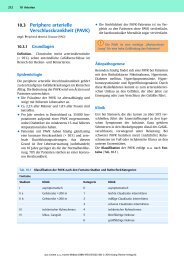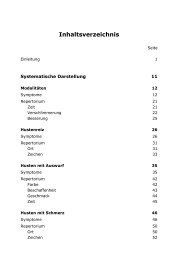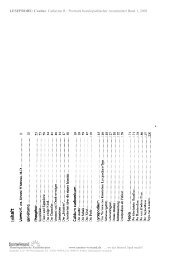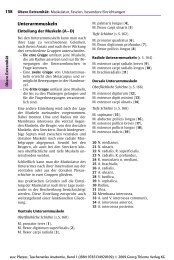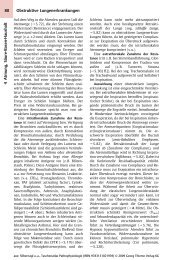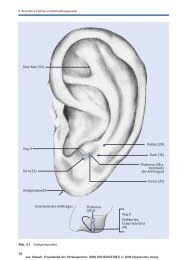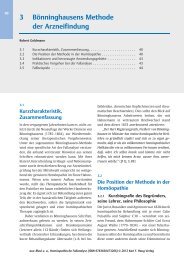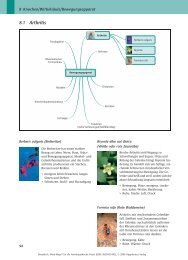alphabetical index of plant families and groups - Sunrise Versand
alphabetical index of plant families and groups - Sunrise Versand
alphabetical index of plant families and groups - Sunrise Versand
Create successful ePaper yourself
Turn your PDF publications into a flip-book with our unique Google optimized e-Paper software.
Native range: Eastern North America. Habitat: Moist bottoml<strong>and</strong> forests;<br />
wooded slopes. Fast-growing, deciduous shrub or small tree, to 8 m high, sending<br />
up a loose colony <strong>of</strong> spiny ash-grey stems from a rhizomatous root system.<br />
Aromatic. Stems ringed with distinctive semicircular leaf scars lined with sharp<br />
tooth-like spines. Leaves clustered at end <strong>of</strong> twigs, fern-like, 2-pinnate, to 2 m<br />
long, borne on long prickly stems, spiny along ribs; leaflets oval, toothed, dark<br />
green above, whitish below. Young leaves bronze-coloured, green in summer,<br />
returning to bronze/red mottled with some yellow before falling in autumn.<br />
Flowers creamy white, in large compound umbels arranged in terminal clusters<br />
30–60 cm long. Male flowers do not open until some time after the female ones<br />
<strong>and</strong> not before some <strong>of</strong> the latter, seemingly impatient from delay, have fallen<br />
unfertilised. Fruit a purplish-black drupe. Easy to grow <strong>and</strong> ‘literally thriving on<br />
neglect’ as one horticulturist has it. It can hardly be called thriving, if that neglect<br />
results in flowers not being pollinated.<br />
‘The fresh bark will produce vomiting <strong>and</strong> purging; but when dried it is a stimulating<br />
alterative, producing a determination toward the surface. The tincture has<br />
been used in syphilitic <strong>and</strong> rheumatic affections, <strong>and</strong> in some diseases <strong>of</strong> the skin.<br />
The warm infusion, especially when strong, is apt to induce vomiting. The berries<br />
in tincture have been found useful in lulling the pain from a decayed tooth; also<br />
in various painful affections <strong>of</strong> other parts. Physicians in Cincinnati made much<br />
use <strong>of</strong> this bark during the cholera <strong>of</strong> 1849–50, in cases where cathartics were<br />
required, but where the action <strong>of</strong> every purgative was difficult to control; the<br />
preparation was composed <strong>of</strong> 1 dram <strong>of</strong> compound powder <strong>of</strong> jalap, 1 dram <strong>of</strong><br />
aralia spinosa <strong>and</strong> 2 drams <strong>of</strong> compound powder <strong>of</strong> rhubarb. Given in powder,<br />
in half-teaspoonful doses; or the powder was infused in half a pint <strong>of</strong> boiling<br />
water, <strong>of</strong> which infusion, when cold, a tablespoonful was given every half hour.<br />
In no case in which it was given did it produce a tendency to looseness or<br />
choleraic discharges. It is a powerful sialagogue <strong>and</strong> is valuable in diseases where<br />
the mouth <strong>and</strong> throat are dry <strong>and</strong> parched, as a very small portion <strong>of</strong> the powder<br />
will produce a moisture <strong>and</strong> relieve difficult breathing; also useful in sore throat.’<br />
[King 1898]<br />
� No symptoms in MM.<br />
Eleutherococcus senticosus<br />
Eleutherococcus senticosus (Rupr. & Maxim.) Maxim.; syns. Hedera senticosa<br />
Rupr. & Maxim.; Acanthopanax sensticosus (Rupr. & Maxim.) Harms. Siberian<br />
ginseng; eleuthero.<br />
Native range: E Asia. Habitat: Understorey species in mixed <strong>and</strong> coniferous<br />
mountain forests. Small, woody shrub, prickly, deciduous <strong>and</strong> slow-growing,<br />
4–6 m high. The oldest stems may be unarmed while the youngest are densely<br />
covered with flexible prickles. Palmate leaves, on long, <strong>of</strong>ten reddish stalks,<br />
usually composed <strong>of</strong> 5 elliptical leaflets with serrate margins. Flowers small,<br />
occurring toward tips <strong>of</strong> stems in single or paired, long-stalked umbels. Fruit a<br />
drupe.<br />
© Saltire Books Ltd<br />
498 Family ARALIACEAE



